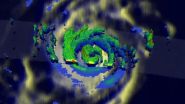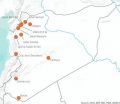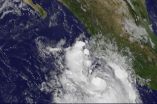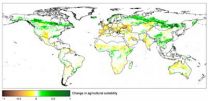(Press-News.org) VIDEO:
On Sept. 17 at 03:39 UTC, the TRMM satellite saw a newer outer eyewall forming around Edouard's original eyewall creating a double eye-wall structure. Red indicates heavy rainfall....
Click here for more information.
NASA's Tropical Rainfall Measuring Mission or TRMM satellite and Aqua satellite gathered data on Hurricane Edouard's rainfall, clouds and waning power is it continued moving northward in the Atlantic into cooler waters. On Sept. 18, NASA's Global Hawk #872 set out to investigate Edouard again as the storm is expected to weaken to a tropical storm
Edouard, which became the fifth named storm of the season after forming on the night of September 11th (EDT) west of the Cape Verde Islands, continued to strengthen as it made its way through the central Atlantic this past week, reaching hurricane intensity on the 14th before becoming the first major hurricane of the season when it peaked briefly as a category 3 storm on the 16th with sustained winds reported at 100 knots (~115 mph) by the National Hurricane Center (NHC). Fortunately, the storm has not posed a threat to the U.S. East Coast due to the presence of a deep-layer trough along the Eastern Seaboard, which has prevented Edouard from moving further westward and forced it to recurve over the central Atlantic.
TRMM Satellite Peers at Edouard's Eyewall Replacement
This latest overpass of Edouard by the TRMM satellite was taken at 03:39 UTC on Sept. 17 (Sept. 16 at 11:39 p.m. EDT) soon after the storm began to recurve to the northeast well east of Bermuda. By this time Edouard had weakened to a category 1 storm with maximum sustained winds reported at 80 knots (~92 mph) by NHC.
However, the TRMM satellite saw that Edouard still had a very robust and mature circulation as evidenced by the presence of a well-defined eye and two concentric bands of rain surrounding the storm's center.
After tropical cyclones reach their peak intensity and continue to age, it's not uncommon for their wind field (i.e., circulation) to expand. That is the case with Edouard, this can happen as the result of an "eyewall replacement cycle" where a newer outer eyewall forms around the original eyewall creating a double eye-wall structure (i.e., the two concentric rainbands) and another ring of stronger winds around the center but further out.
At that time, Edouard's minimum central pressure was 959 millibars and is nearly as low as it was when Edouard was a category 3 hurricane on the Saffir-Simpson scale, but the pressure gradient is now spread over a larger area, which reduces the storm's peak wind intensity but increase the extent of stronger winds over a larger area.
Getting a 3-D Look at the Storm
At NASA's Goddard Space Flight Center in Greenbelt, Maryland the TRMM team created a 3-D image of Edouard using TRMM Precipitation Radar data. The 3-D image showed that there was little in the way of the tall convective (rising air that forms) thunderstorm towers that can energize the storm's circulation. That's because Edouard was beginning to move over cooler waters. TRMM is a joint mission between NASA and the Japanese space agency JAXA.
NASA's Aqua Satellite Passed Over Edouard
On Sept. 17 at 12:40 p.m. EDT the Moderate Resolution Imaging Spectroradiometer or MODIS instrument aboard NASA's Aqua satellite took a visible picture of Hurricane Edouard in the Atlantic Ocean. Edouard's eye had become obscured by high clouds. The image revealed bands of thunderstorms spinning into the center from the northern and southern quadrants. The image was created by the NASA Goddard MODIS Rapid Response Team at NASA Goddard.
NASA's HS3 Mission Flying Over Edouard Sept. 18
The remotely piloted Global Hawk aircraft is part of NASA's airborne Hurricane and Severe Storm Sentinel, or HS3 mission that has been investigating tropical cyclones in the Atlantic this summer. The Global Hawk took off from NASA's Wallops Flight Facility, Wallops Island, Virginia, at 7:15 EDT to start Science Flight #8 to Hurricane Edouard
On Sept. 18 at 8 a.m. EDT, the National Hurricane Center noted the Edouard was still a hurricane despite moving over waters near 24 Celsius (75.2 Fahrenheit). Sea surface temperatures of at least 26.6C (80F) are needed for a hurricane to maintain strength, so it's only a matter of time until Edouard weakens below hurricane status.
Where is Edouard?
At 5 a.m. EDT on Sept. 18, the center of Hurricane Edouard was located near latitude 39.6 north and longitude 45.3 west. Edouard was moving toward the east-northeast near 28 mph (44 kph) and is expected to slow down as it moves eastward. Maximum sustained winds remain near 85 mph (140 kph) and weakening is forecast during the next 48 hours.
Edouard continues to move to the northeast away from the U.S. and is expected to begin to weaken and become post tropical before winding up somewhere west of the Azores in the next few days.
INFORMATION:
Stephen Lang / Rob Gutro
SSAI/NASA Goddard Space Flight Center
NASA sees Hurricane Edouard enter cooler waters
2014-09-18
ELSE PRESS RELEASES FROM THIS DATE:
Scientists find how mysterious 'circular RNA' is formed, claim muscular dystrophy link
2014-09-18
Our genetic information is stored in DNA, tiny strands of nucleic acid that contain instructions for the functioning of our bodies. To express this genetic data, our DNA is copied into RNA molecules, which then translate the instructions into proteins that perform tasks in our cells.
Several years ago, scientists discovered a new type of RNA molecule. Unlike all other known RNAs, this molecule is circular, and was labeled circular RNA. Although circRNA molecules are abundant, little has been known about how they are produced. Moreover, little has been known about the ...
Flu vaccine for expectant moms a top priority
2014-09-18
WHITE PLAINS, NY, SEPT. 18, 2014 -- Only about half of all pregnant women in the U.S. get a flu shot each season, leaving thousands of moms-to-be and their babies at increased risk of serious illness.
"Getting a flu shot should be a routine part of prenatal care," said Edward McCabe, MD, March of Dimes chief medical officer. "Health care providers should offer their pregnant patients a flu shot each year and if they don't, then women should ask for it."
A report by the U.S. Centers for Disease Control and prevention presented today by the National Foundation for ...
New high-resolution satellite image analysis: 5 of 6 Syrian World Heritage sites 'exhibit significant damage'
2014-09-18
SEPTEMBER 18 —In war-torn Syria, five of six World Heritage sites now "exhibit significant damage" and some structures have been "reduced to rubble," according to new high-resolution satellite image analysis by the nonprofit, nonpartisan American Association for the Advancement of Science (AAAS).
The AAAS analysis, offering the first comprehensive look at the extent of damage to Syria's priceless cultural heritage sites, was completed in partnership with the University of Pennsylvania Museum of Archaeology and Anthropology's Penn Cultural Heritage Center (PennCHC) and ...
NASA marks Polo for a hurricane
2014-09-18
Hurricane Polo still appears rounded in imagery from NOAA's GOES-West satellite, but forecasters at the National Hurricane Center expect that to change.
NOAA's GOES-West satellite captured data on Hurricane Polo on Sept. 18 at 10:15 a.m. EDT. An image using that data was created by the NASA/NOAA GOES Project at NASA's Goddard Space Flight Center in Greenbelt, Maryland. The image showed thunderstorms wrapping tightly around the center of the storm while one broken band of thunderstorms extended to the northwest, while the other appeared on the eastern side of the center ...
New Dartmouth smartphone app reveals users' mental health, performance, behavior
2014-09-18
Dartmouth researchers and their colleagues have built the first smartphone app that automatically reveals students' mental health, academic performance and behavioral trends. In other words, your smartphone knows your state of mind -- even if you don't -- and how that affects you.
The StudentLife app, which compares students' happiness, stress, depression and loneliness to their academic performance, also may be used in the general population – for example, to monitor mental health, trigger intervention and improve productivity in workplace employees.
"The StudentLife ...
Fall foliage season may be later, but longer on warmer Earth
2014-09-18
The fall foliage season that prompts millions of Americans to undertake jaunts into the countryside each year could come much later and possibly last a little longer within a century, according to new research.
Climate change could postpone fall leaf peeping in some areas of the United States as summer temperatures linger later into the year, Princeton University researchers report in the journal Global Ecology and Biogeography. For instance, the paper birch — a popular foliage tree that is the state tree of New Hampshire — could change color one to three weeks later ...
Want to link genes to complex traits? Start with more diversity
2014-09-18
Life is rarely simple. From crop yields to disease risks, the biological characteristics people care most about are usually those considered "complex traits." Just as for height—the textbook example of a complex trait—attributes like risk for a particular human disease are shaped by multiple genetic and environmental influences, making it challenging to find the genes involved. To track down such genes, geneticists typically mate two individuals that differ in key ways—for example, a large mouse and a small mouse—and then study their descendents, looking for genes that ...
Americans rate losing eyesight as having greatest impact on their lives
2014-09-18
ALEXANDRIA, Va.—Sept. 18, 2014—Many Americans across racial and ethnic groups describe losing eyesight as potentially having the greatest impact on their day-to-day life, more so than other conditions including: loss of limb, memory, hearing and speech (57% of African-Americans, 49% of non-Hispanic whites, 43% of Asians and 38% of Hispanics). When asked which disease or ailment is the worst that could happen to them, blindness ranked first among African-Americans followed by AIDS/HIV. Hispanics and Asians ranked cancer first and blindness second, while Alzheimer's disease ...
Living in a disadvantaged neighborhood worsens musculoskeletal pain outcomes after trauma
2014-09-18
CHAPEL HILL, N.C. – Individuals living in disadvantaged neighborhoods have worse musculoskeletal pain outcomes over time after stressful events such as motor vehicle collision than individuals from higher socioeconomic status neighborhoods, even after accounting for individual characteristics such as age, sex, income, education, and employment status.
These were the findings of a multi-site research study led by Samuel McLean, MD, MPH, associate professor of anesthesiology and emergency medicine at the University of North Carolina School of Medicine. The results of the ...
Global agriculture: More land, fewer harvests
2014-09-18
According to a simulation of the impact of climate change on agricultural production over the course of the 21st century, carried out by researchers led by Professor Wolfram Mauser at LMU's Department of Geography, some two-thirds of all land potentially suitable for agricultural use is already under cultivation. The study indicates that climate change will expand the supply of cropland in the high latitudes of the Northern hemisphere (Canada, Russia, China) over the next 100 years. However, in the absence of adaptation measures such as increased irrigation, the simulation ...







